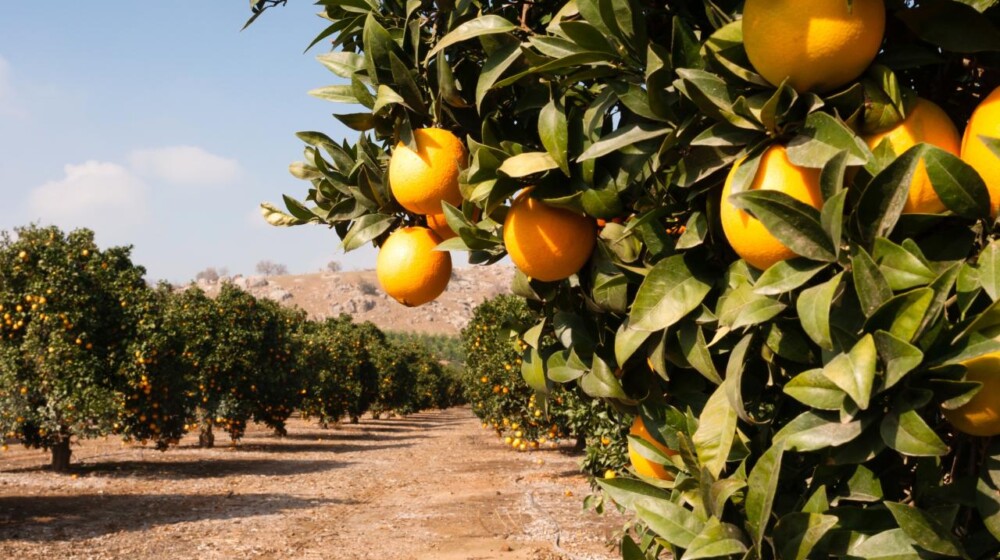C is for Citrus
Posted August 1, 2024
Written by Heather Roberts, Research Historian
For a printable, PDF version of this article, please click here.
Did you know…
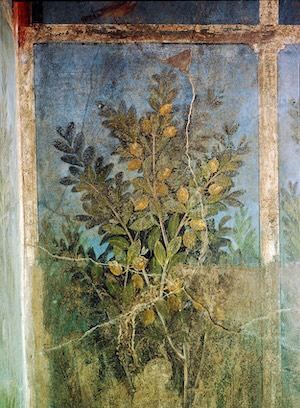
An ancient fresco of a lemon tree at Pompeii, Italy, courtesy of the Special Superintendency for the Archaeological Heritage of Naples and Pompeii.
Scientists have been able to pinpoint the origin of citrus plants back millions of years to the area around the foothills of the Himalayas in Asia, where four ancestral species first grew – citrons, mandarins, pummelos, and micrantha. These plants came to the Mediterranean (they were popular in ancient Greece, Rome, and Egypt) through the Middle East around 3-2 BCE, and were hybridized over thousands of years to give us the citrus fruit we recognize today in the produce section of our grocery stores. These citrus fruits, among many other things, were brought to the Americas via European colonizers sometime in the 16th century, with the first orange trees in the US planted near St. Augustine in what is now Florida.
-
More Info: Avast ye scurvy dogs!
Pirates, sailors, and anyone else who sailed on months-long sea voyages could encounter many dangers, but their biggest enemy turned out to be their own diets. With the length of these trips, had very little access to fresh fruits and vegetables, and relied instead on food that could be preserved, like salted meat and hardtack. Within just a couple months, sailors would fall ill with a mystery ailment that attacked its victims with extreme fatigue and lethargy, bleeding gums, swelling of extremities, internal hemorrhaging and bruising, open sores, loss of hair and teeth, and eventual death. This mystery illness, which they called scurvy, would kill over two million sailors between the late 15th and mid-19th centuries. Though the cause of the disease (a Vitamin C deficiency) wasn’t fully confirmed until the 20th century by Dr. Albert Szent-Györgyi of Hungary, the British navy followed evidence that citrus fruits worked best at treating and preventing scurvy, and in 1796 first mandated lemon juice as part of their sailors’ diet. Although limes had less Vitamin C than lemons and were less effective, the British navy eventually used those fruits due to their greater availability from British colonized land in the Caribbean. This use led to the nickname “limey” for British sailors.
 More scurvy facts:
More scurvy facts:-
- Unlike humans, most animals (including cats and dogs) have a gene called L-Gulonolactone oxidase (GULO) that helps them make their own Vitamin C internally. Like humans, though, apes, bats, guinea pigs, and insects do not have the gene and have to get their Vitamin C from the foods they eat.
- Though this disease is mostly thought of in connection with pirates and sailors in the past, scurvy still affects people today. People who live in food deserts, those who live in poverty, the elderly, people who are in prison, and the unhoused are particularly vulnerable to this disease.
- Great sources of Vitamin C include citrus fruits, broccoli, white potatoes, green and red chilis, tomatoes, cauliflower, kiwis, and strawberries.
-
It’s thought that Father Eusebio Kino, a Jesuit priest and missionary, brought citrus fruits/plants with him to what is now Southern Arizona in the late 1600s. But they don’t seem to have made their way up to the Phoenix area until the 1890s, after the Arizona Canal was able to bring an adequate and consistent amount of water to the now-Glendale area for citrus trees to grow. Some of that growth was realized by Heritage Square’s Silva family at their farm in Glendale, appropriately named Orange Ranch, where they grew citrus trees and other crops, as well as raising horses and cattle. The Gammel family – owners/residents of Rosson House from 1914 to 1948 – also owned a 40 acre orange and lemon grove from 1910 to 1918, located around 40th Street & Indian School. And, according to Jesse Jean Higley) Lane in her interview with Heritage Square, Rosson House itself had a large grapefruit tree on the southeast side of the home – possibly the one in the photo of Billie Gammel seen here, c1940.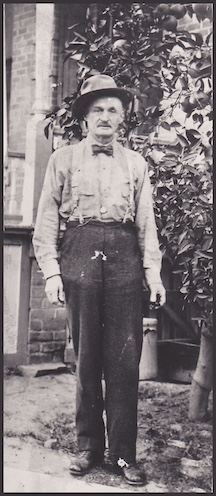
When in season, oranges were a frequent part of the average middle class diet in the late 19th and early 20th centuries, but the same can’t be said of diets of the working class and the poor. As inexpensive as their citrus fruit prices seem to us today – in December 1899 you could buy a dozen oranges in Phoenix for as little as 15 cents (!!) – families with little income often already spent around half of their money or more on food basics like cheap bread, meat, butter and milk, tubers, and less costly fruits and vegetables like apples, cabbage, and canned tomatoes. (Dirk, 55, 69-85) Other fruits and vegetables were sometimes available/affordable seasonally, and citrus may have been included on that list in places with temperate climates like Arizona.
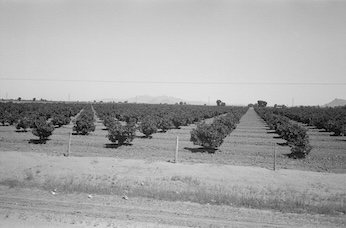
An Arizona citrus grove, 1940, Library of Congress.
As commercial citrus production grew rapidly in the new state, packing and distribution issues were smoothed out by the Arizona Citrus Growers Association, created in 1928 to represent the citrus growers and better coordinate the most effective ways to move and market their produce. The Phoenix area would eventually have a dozen citrus packing plants, and nationally known companies like Sunkist sold Arizona citrus fruit under their brand. State and local tourism authorities used Arizona’s five top economic drivers – citrus, climate, copper, cattle, and cotton – in marketing campaigns to promote the 48th state as a great place to visit and live, calling them Arizona’s 5 Cs. Citrus production in Arizona peaked at around 80,000 acres in cultivation in the 1970s, but it’s dwindled since then due to urban growth, citrus diseases, and drought. Today, the US Department of Agriculture only tracks lemon production in Arizona – which was up by 16% in the 2022/2023 season – as the amount of all other citrus production is too low. The last packing plant in the Phoenix area – the Sunkist Warehouse – closed in 2010.
Though there aren’t as many of them around these days, there are still commercial citrus farms in the Phoenix area. Show them your support by heading out to weekend farmers markets to get a bag of locally grown grapefruit, or to the groves themselves to pick your own oranges, lemons, and limes – you can find a Top 10 list of them here.
-
More Info: When life hands you lemons...
Lemonade is Arizona’s official state beverage, and National Lemonade Day is celebrated this month on August 20th. Here’s a little history about the tasty drink:
-
- A treatise called On Lemon, Its Drinking and Use, was written in 12 CE by Ibn Jumay, a physician who served in the court of Saladin (Egypt). He promoted lemons for their medicinal properties, saying they helped with indigestion, bad breath, headaches, sore throats, and even hangovers, and included recipes for lemon drinks in his writing.
- In the 17th century, carbonated lemonade sold by sidewalk vendors in Paris was so popular, all the vendors came together in 1676 to form a union called the Compagnie de Limonadiers.
- The early American cookbook, The Virginia Housewife (1824), includes egg whites in its lemonade recipe. In what’s thought to be the first ever cocktail book, Oxford Night Caps (1827), lemonade ingredients include calves-feet jelly and fresh eggs. And in the Beeton’s Cookery Book and Household Guide (1898), their recipe for lemonade suggests watering it down for children, and adding egg white and/or sherry for adults.
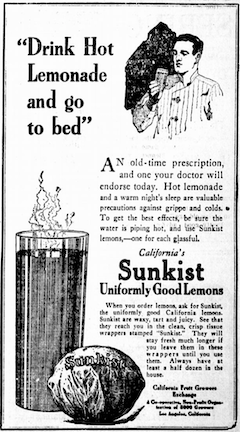
- Lemonade was a popular drink for the temperance movement in the US. First Lady Lucy Hayes was nicknamed “Lemonade Lucy” after banning alcoholic drinks in the White House during her husband’s term (Rutherford B. Hayes, 1877-81).
- Rumor has it that Arizona’s first governor, George Hunt, would stop to visit the Gammel family at Rosson House after a long day of work at the capitol building, where he would sit on the front porch and drink “lemonade”. Learn how to make our version of Governor Hunt’s Lemonade from this video.
- Hot lemonade was promoted in newspapers as a health drink in the late 19th and early 20th centuries for people with colds, and also for those who became ill during the 1918 influenza epidemic.
-
Learn more about Arizona’s 5 Cs from our other blog articles, C is for Cattle (April 2023), and C is for Climate (October 2018), as well as through our History at Home educational activities.
Discover more about the interesting life of Dr. Albert Szent-Györgyi, who won the Nobel Prize in Physiology/Medicine in 1937 for his work studying ascorbic acid (Vitamin C) and cellular respiration, and who helped found the National Foundation for Cancer Research.
Information for this blog article was found in the Heritage Square archives, and online through the links already shared in this article as well as: Chronicling America digital newspaper archive; the American Society for Horticultural Science – The Citrus Route Revealed: From Southeast Asia into the Mediterranean; Nature – Genomics of the origin and evolution of Citrus; Scientific American – We Finally Know Where Oranges and Lemons Come From; On Lemon: A Global History, by Toby Sonneman; Florida Department of Citrus – What is the history of Citrus?; California Farm Bureau – The History of Citrus in California; Distillations Magazine (Science History Institute Museum & Library) – The Age of Scurvy; National Foundation for Cancer Research – The Full Story of Dr. Albert Szent-Györgyi; BBC News – James Lind: The man who helped cure scurvy…; National Library of Medicine – Scurvy in the Modern World: Extinct or Not?; National Institutes of Health – Vitamin C; Food in the Gilded Age: What Ordinary Americans Ate, by Robert Dirks (via Internet Archive); Valley 101 Podcast via AZ Central – Why is citrus one of the five Cs of Arizona?; Progressive Agriculture, Vol. 17, No. 6 (1965) – History of Citrus in Arizona (PDF); USDA National Agricultural Statistics Service – Citrus Summary 1983 (PDF); National Agricultural Statistics Service, USDA (via Cornell Library) – Citrus Fruits 2023 Summary (PDF); Gilbert Historical Museum – Citrus One of the 5 C’s of Arizona; Arizona Highways – Citrus in Arizona; AZ Central – Citrus squeeze: Pushed by development, costs, citrus shrinks…; Arizona Department of Agriculture – Citrus; Minerva’s Kaleidoscope (Library of Congress Blog) – Cooking Up History: Lemonade; Atlas Obscura –The Sweet History of Lemonade; the Museum of Ventura County – Lemonade; and Smithsonian Magazine – How Kids Cornered the Market on Lemonade.

Archive
-
2024
-
December (1)
-
November (1)
-
October (1)
-
September (1)
-
August (1)
-
July (1)
-
June (1)
-
May (1)
-
April (1)
-
March (1)
-
February (1)
-
January (1)
-
-
2023
-
December (1)
-
November (1)
-
October (1)
-
September (1)
-
August (1)
-
July (1)
-
June (1)
-
May (1)
-
April (1)
-
March (1)
-
February (1)
-
January (1)
-
-
2022
-
December (1)
-
November (1)
-
October (1)
-
September (1)
-
August (1)
-
July (1)
-
June (1)
-
May (1)
-
April (1)
-
-
2021
-
December (1)
-
November (1)
-
October (1)
-
September (1)
-
August (1)
-
July (1)
-
June (1)
-
May (1)
-
April (1)
-
March (1)
-
February (1)
-
January (1)
-
-
2020
-
December (1)
-
November (1)
-
October (1)
-
September (1)
-
August (1)
-
July (1)
-
June (1)
-
May (1)
-
April (1)
-
March (1)
-
February (1)
-
January (1)
-
-
2019
-
December (1)
-
November (1)
-
October (1)
-
September (1)
-
August (1)
-
July (1)
-
June (1)
-
May (1)
-
April (1)
-
March (1)
-
February (1)
-
January (1)
-
-
2018
-
December (1)
-
November (1)
-
October (1)
-
September (1)
-
August (1)
-
July (1)
-
May (1)
-
April (1)
-
March (1)
-
February (1)
-
January (1)
-
-
2017
-
December (1)
-
November (1)
-
October (1)
-
September (1)
-
August (1)
-
July (1)
-
June (1)
-
May (1)
-
April (1)
-
March (1)
-
February (1)
-
January (1)
-
-
2016
-
December (1)
-
-
2015
-
2014
-
July (1)
-
